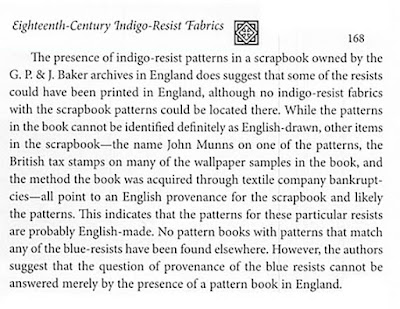 Smithsonian Collection Caption
Smithsonian Collection CaptionThe geographic source for these early indigo resist prints and the bedcovers made from them is a good topic for discussing hypotheses and their proofs. Over the past 100 years several scholars, curators and textile enthusiasts have expressed hypotheses ---educated guesses---on where they originated. Few have followed the principles of logic to prove their hypotheses.
Winterthur Museum Collection
Pomegranate print with a later cactus print border
Creative people often come up with fresh perspectives in hypotheses. In the 1950-1980's the Cooper-Hewitt Museum contingent (Hathaway, Beer & Pettit) presented several ideas about sources, primarily the idea that artisans in the Hudson River Valley printed indigo resist cottons and stitched wholecloth bedcovers from the cotton before 1800.
Very little evidence supports this hypothesis aside from the many such objects found in the region. To methodically look at the support for their idea I created a simple evidence checklist.

-------------------------------
Looking at the evidence...

....only one box can be checked.
See the last post for reasons that might have motivated people in the Cold War era to ignore the lack of American evidence. Fear of political reprisal seems hardly a reason to cling to an illogical conclusion but motivation is often complex (and the 1950s were tough.)
Western Kentucky University Collection
A scrap that Florence Peto of New Jersey shared with
Elizabeth Richardson
One might argue that fabric production as long ago as 1790 is too old to document but we can look at early U.S. textile production and find fabric that clearly was domestically printed in the history of the John Hewson printworks in Philadelphia, established in 1774.
-----

--------------------
Several years ago Merikay Waldvogel and I spent much time discussing origins of furnishing panels found in chintz quilts made along the southern Atlantic coast. We were particularly interested in panels abundant in American bedcovers but not found in England or other places that might have had the technology to print them in the first half of the 19th century.
"Trophy of Arms" panel in a quilt in Donna Stickovich's collection
-----

------------
This panel is common in American quilts but not seen abroad. We guessed it might have been printed here. Evidence shown above indicates our hypothesis was wrong.
Block dated 1845 from inventory of GB's Best
I also once guessed that the enormous variety of multicolored calicos with Turkey red grounds seen in American patchwork after 1840 must have been printed here---a false hypothesis. They were a European import, a characteristic product of Scotland at that time.
Much evidence of Scottish production:

----
As we can see from the checklist the only evidence we might have for American manufacture at that point is the presence of the textiles. Abundant though the patchwork is we have nothing else to tell us that mills in New England produced these popular Turkey red commodities until after the Civil War---1870 or so.
So where were the early Indigo Resist cottons printed?
Next post---Maybe England?







































































